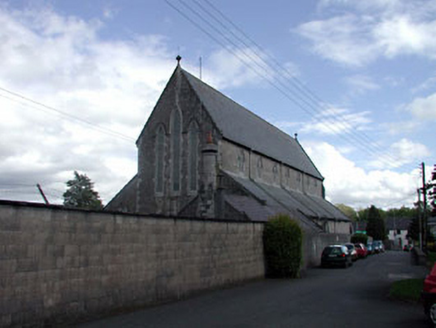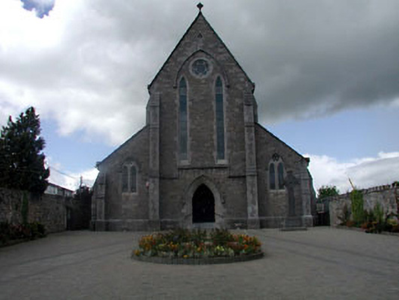Survey Data
Reg No
11805042
Rating
Regional
Categories of Special Interest
Architectural, Historical, Scientific, Social
Original Use
Church/chapel
In Use As
Church/chapel
Date
1855 - 1860
Coordinates
297330, 233152
Date Recorded
14/05/2002
Date Updated
--/--/--
Description
Detached seven-bay double-height Catholic church, built 1857-9, on a rectangular plan comprising seven-bay double-height nave opening into seven-bay single-storey lean-to side aisles. Renovated, ----, with sanctuary reordered. Pitched slate roof; lean-to slate roofs (side aisles), roll moulded ridge tiles, cut-limestone "slated" coping to gables on roll-topped gabled kneelers with Celtic Cross finials to apexes, and cast-iron rainwater goods on exposed timber rafters retaining cast-iron hoppers and downpipes. Snecked limestone walls on cut-limestone chamfered cushion course on plinth with clasping stepped buttresses to corners having cut-limestone "slated" coping. Trefoil-detailed pointed-arch window openings (clerestorey) with cut-limestone mullions, and cut-limestone block-and-start surrounds having chamfered reveals with hood mouldings on monolithic label stops framing storm glazing over fixed-pane fittings having lattice glazing bars. Lancet window openings (side aisles) with cut-limestone block-and-start surrounds having chamfered reveals framing storm glazing over fixed-pane fittings having leaded stained glass panels. Lancet "Trinity Window" (east), cut- or hammered limestone block-and-start surrounds having chamfered reveals with hood moulding on monolithic label stops framing storm glazing over fixed-pane fittings having leaded stained glass panels. Pointed-arch door opening to entrance (west) front with flight of four cut-limestone steps, cut-limestone block-and-start surround having moulded reveals with hood moulding on monolithic label stops framing timber boarded double doors. Pair of lancet window openings with cinquefoil "Rose Window" (gable), cut- or hammered limestone block-and-start surrounds having chamfered reveals with hood moulding on monolithic label stops framing storm glazing over fixed-pane fittings having leaded stained glass panels. Interior including vestibule (east); square-headed door openings into nave with glazed timber panelled double doors centred on glazed timber panelled double doors having overlight; full-height interior open into roof with arcaded choir gallery (east) below stained glass "East Window" (----), carpeted central aisle between timber pews, pointed-arch arcades on pillars, carpeted stepped dais to sanctuary (west) reordered, ----, with Gothic-style high altar (1912-3) below stained glass "Trinity Window" (----) in mosaic tiled surround (1915), encaustic tiled stepped daises to side altars, exposed pointed-arch braced scissor truss timber roof construction on beaded corbels with wind braced rafters to ceiling on carved timber cornice, timber panelled confessional boxes (side aisles), pair of Gothic-style wall monuments (----), paired timber stations between stained glass windows, and exposed strutted timber roof constructions on beaded corbels with wind braced rafters to ceilings on carved timber cornices. Set in landscaped grounds.
Appraisal
A church erected to designs by James Joseph McCarthy (1817-82) of Great Brunswick Street [Pearse Street], Dublin (The Builder 28th March 1857, 179; 27th March 1858, 214; Dublin Builder 1st July 1859, 80), representing an important component of the mid nineteenth-century built heritage of Celbridge with the architectural value of the composition, one recalling the Augustus Welby Northmore Pugin (1812-52)-designed Catholic Church of Saint Alphonsus Liguori (1844-8) in County Wexford where '[a] central high pitched nave [is] held in place by steeply-raked aisles' (see 15703738), confirmed by such attributes as rectilinear plan form, aligned along an inverted liturgically-correct axis; the construction in a mottled limestone with sheer dressings demonstrating good quality workmanship; and the slender profile of the openings underpinning a "medieval" Gothic theme with the chancel defined by an elegant "Trinity Window". Having been well maintained, the form and massing survive intact together with substantial quantities of the original fabric, both to the exterior and to the arcaded interior reordered (----) in accordance with the liturgical reforms sanctioned by the Second Ecumenical Council of the Vatican (1962-5) where contemporary joinery; a much modified high altar attributed to John Patrick Fitzgerald Munden (1883-1962) of Dublin (DIA); mosaic work by Ludwig Oppenheimer (established 1865) of Manchester; wall monuments; and stained glass produced by John Hardman and Company (closed 2008) and William Wailes (1808/9-81) of Newcastle (The Builder 27th March 1858, 214), all highlight the artistic potential of the composition: meanwhile, an exposed timber roof construction pinpoints the engineering or technical dexterity of a church forming part of a self-contained group alongside an adjacent convent (see 11805043) with the resulting ecclesiastical ensemble making a pleasing visual statement in Main Street.



